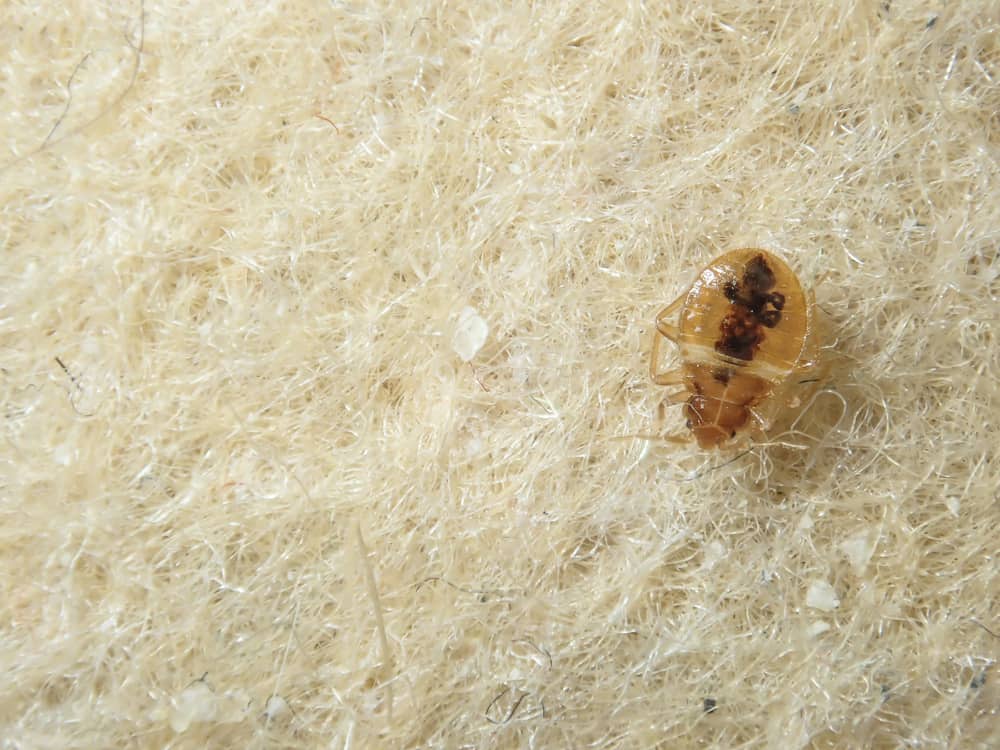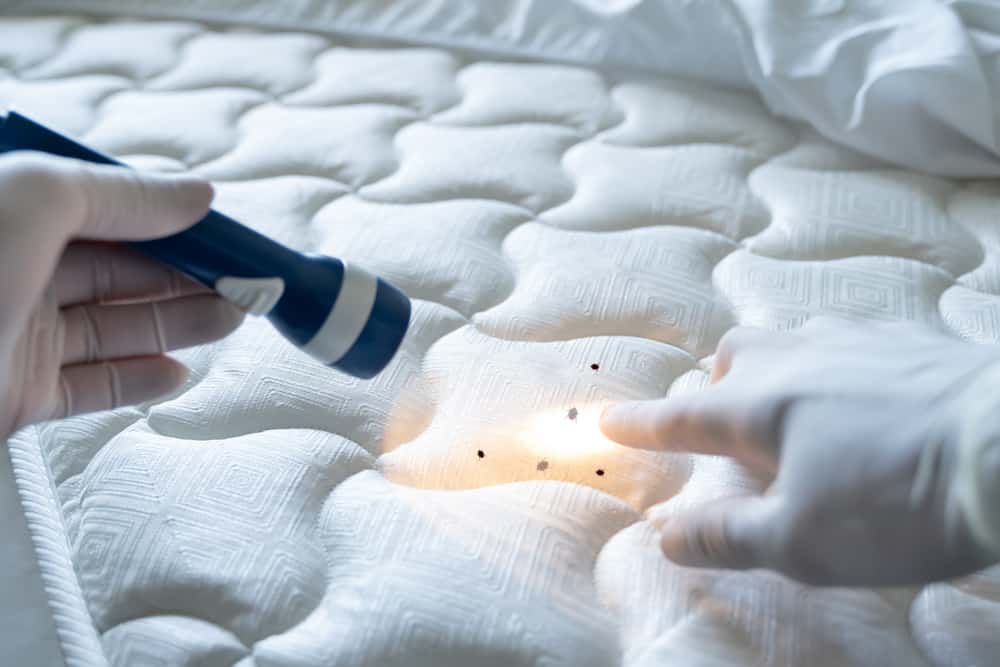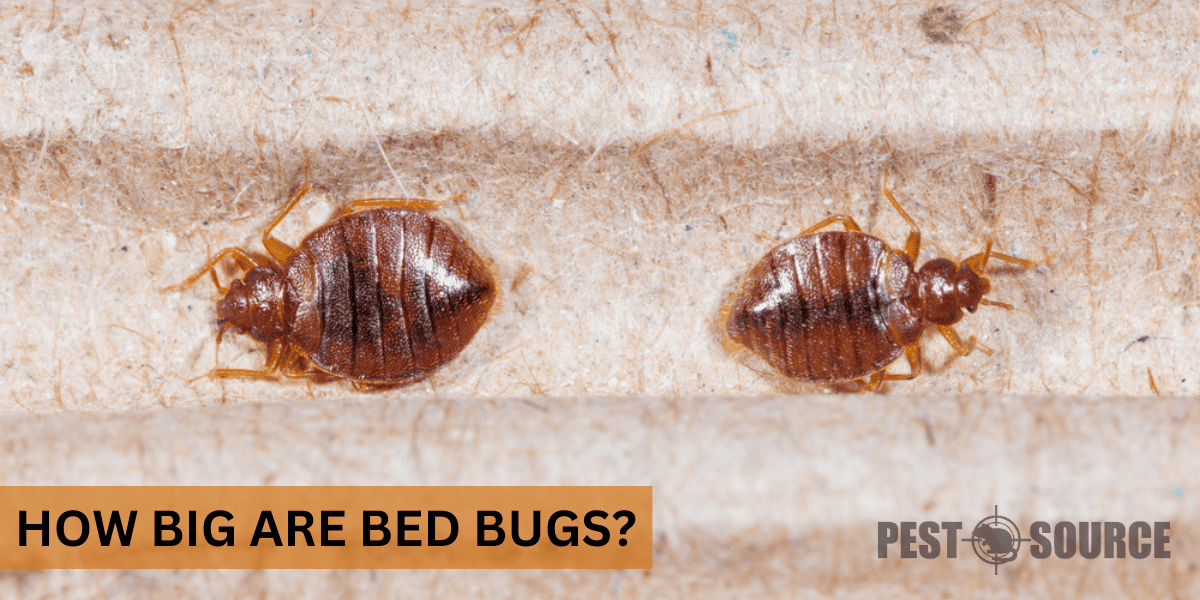Bed bugs are small, with adults typically measuring about 5-7 millimeters in length, roughly the size of an apple seed. Their size can vary slightly depending on their feeding status, with engorged bed bugs appearing larger and more reddish-brown. This post will provide a visual guide to help identify bed bugs and distinguish them from other common household pests.
POINTS
- Bed bugs range in size depending on their life stage, from tiny 1-millimeter eggs to adult bugs measuring between 5 to 7 millimeters in length, similar in size to an apple seed.
- Visibility of bed bugs can be impacted by factors such as their life stage, color, and the presence of hiding spots, with early-stage nymphs and eggs being the most difficult to spot with the naked eye.
- A bed bug’s size can vary based on factors such as their life stage, sex, feeding status, and genetics, with engorged adult females reaching up to 9 millimeters in length.
- Identifying bed bugs based on their size, color, and shape can help detect and control infestations more effectively, recognizing their presence through bite patterns, fecal spots, bloodstains, and shed exoskeletons.
- Understanding the actual size of bed bugs at various life stages can significantly enhance early detection and prevention efforts, ensuring you can take appropriate action to eliminate these pests and prevent their spread.
A Brief Overview of Bed Bugs
What are bed bugs?
Bed bugs are small, wingless insects that belong to the family Cimicidae. They are parasites that feed on the blood of humans and other warm-blooded animals. Bed bugs are known for their preference to stay close to their human hosts, often living in mattresses, furniture, and other areas where people sleep or spend time. These clever insects are opportunistic feeders, taking advantage of the night when their host is asleep and less likely to notice their bites.
Why is understanding the size of bed bugs important?
A proper understanding of the size of bed bugs is crucial for several reasons:
- Detection: Knowing the size of bed bugs helps to recognize them more easily in various stages of development. This is important for early detection and rapid intervention to prevent an infestation from becoming unmanageable.
- Monitoring: Following an extermination process, understanding the size of bed bugs helps differentiate between dead and live bugs, and mature and immature bugs. This knowledge assists in gauging the effectiveness of the extermination methods and the progress of control measures.
- Prevention: Awareness of bed bug size at different stages of their life cycle raises overall vigilance and is vital in stopping their spread, as often new infestations start with a few overlooked juvenile bed bugs or eggs.
The Size of Bed Bugs at Different Life Stages
How big are bed bugs at the egg stage?
Bed bug eggs are minuscule, measuring roughly 1 millimeter in length. They have an elongated shape and are translucent, which can make them difficult to detect. Their color may vary from almost transparent to a milky-white shade as they progress towards hatching.
What is the size range of bed bug nymphs from the 1st to the 5th instar?
Bed bug nymphs, or juveniles, undergo five development stages or instars before reaching adulthood. Their size varies according to their stage of development:
- 1st instar: Approximately 1.5 millimeters in length
- 2nd instar: About 2 millimeters in length
- 3rd instar: Roughly 2.5 millimeters in length
- 4th instar: Around 3 millimeters in length
- 5th instar: Approximately 4.5 millimeters in length
How big are nymph bed bugs and how do they differ in size from the adult stage?

As mentioned earlier, nymph bed bugs range in size from about 1.5 to 4.5 millimeters in length, depending on their development stage. In comparison, adult bed bugs are larger, typically measuring between 5 to 7 millimeters in length. Nymphs are often lighter in color as compared to adults, which can make detecting them more difficult.
How big are adult female bed bugs?
Adult female bed bugs measure between 5 to 7 millimeters in length, although some can reach up to 9 millimeters when engorged. They are usually slightly larger than males, with a more rounded and oval-shaped body.
How big are adult male bed bugs?
Adult male bed bugs size similar to females, with a length of about 5 to 7 millimeters. They can be distinguished from females by their body shape, as males have a narrower and more pointed abdomen.
Bed Bug Size in Comparison to Everyday Objects
What common objects can bed bugs be compared to for a better size understanding?
Though exact sizes can vary depending on the individual bug, using everyday objects to compare size can help with understanding just how big bed bugs can be.
- Bed bug eggs: Comparable to a single grain of salt
- 1st and 2nd instar nymphs: Close to the size of a poppy seed
- 3rd and 4th instar nymphs: Similar in size to a sesame seed
- 5th instar nymphs and adult bed bugs: About the size of an apple seed
Are bed bugs visible to the naked eye at all stages?
While bed bugs are generally visible to the naked eye, their visibility is greatly influenced by their life stage and coloration. Eggs and first instar nymphs can be particularly challenging to spot, as they are tiny and pale-colored. As they grow and darken in color, bed bugs become more noticeable.
How does the size of a bed bug compare to an apple seed?
Adult bed bugs are roughly equivalent in size to an apple seed, measuring around 5 to 7 millimeters in length. This comparison is helpful for people trying to identify bed bugs during an infestation, as it provides a point of reference for estimating their size.
Variability in Size of Bed Bugs
How much can the size of bed bugs vary?
The size of bed bugs can vary depending on factors such as sex, life stage, feeding status, and genetics. Adult bed bugs range between 5 to 7 millimeters in length, with females being slightly larger than males. After feeding, bed bugs can almost double in size due to the blood intake and engorgement of their bodies.
How big can a bed bug get?
A fully engorged adult female bed bug can potentially reach up to 9 millimeters in length. However, this size is rare, and it is more likely to encounter bed bugs within the typical 5 to 7 millimeter range.
How small can a bed bug be?
Freshly hatched bed bug nymphs are the smallest, with the 1st instar measuring only about 1.5 millimeters in length.
Are there differences in size between large and small bed bugs?
Yes, there are significant differences in size between various life stages, gender, and feeding status of bed bugs. Generally, larger bed bugs can indicate a thriving infestation with mature adults and a consistent food source, while smaller bed bugs could represent nymphs or potentially stressed or malnourished adults.
Are there any factors that influence the size of a bed bug?
Several factors can influence the size of a bed bug, including:
- Life stage: Bed bugs grow larger as they progress through the five nymph stages before reaching adulthood.
- Sex: Female bed bugs are usually slightly larger than males.
- Feeding status: Bed bugs can grow significantly larger after a blood meal due to engorgement.
- Genetics: There may be some minor variations in size due to genetic factors.
The Visibility of Bed Bugs: A Reality Check
Are bed bugs visible to the naked eye?
Yes, bed bugs are visible to the naked eye, but visibility depends on the insect’s life stage, color, and size. While eggs and early-stage nymphs are quite small and difficult to spot, late-stage nymphs and adult bed bugs are generally easier to see due to their larger size and darker coloration. However, their flat, oval-shaped body makes it easier for them to hide in small gaps and crevices, making detection more challenging.
What makes it difficult to see bed bugs?
Several factors make it hard to see bed bugs, including:
- Size and color: Eggs and young nymphs are small and light-colored, making them challenging to spot against light-colored surfaces.
- Camouflage: Bed bugs can hide in small cracks, crevices, seams, and folds of bedding, furniture, and other household items, providing them with natural camouflage.
- Nocturnal behavior: These pests are primarily active at night when their hosts are asleep, making it less likely for people to notice them during the day.
- Low infestation: In the initial stages of an infestation, the number of bed bugs present may be low, making it harder to detect them.
What is the actual size of a bed bug as visible to the naked eye?
The actual visible size of a bed bug to the naked eye can vary depending on the stage of development and other factors. Adult bed bugs are the easiest to spot, measuring between 5 to 7 millimeters in length. Late-stage nymphs can be slightly more difficult to see, ranging from 2.5 to 4.5 millimeters. Meanwhile, eggs and early-stage nymphs are quite small, making them challenging to notice without careful inspection or magnification.
Color and Appearance of Bed Bugs Depending on Their Size and Feeding Status
What color are bed bugs before and after feeding?
Bed bugs change color as they develop and after feeding. Before feeding, nymphs are pale and almost translucent, ranging from light tan to a yellowish-white. Adult bed bugs are typically brown, with their bodies appearing slightly reddish-brown after feeding due to the visibility of the consumed blood. More on what bed bugs look like to the human eye.
How does the feeding status of a bed bug affect its size and appearance?
When a bed bug feeds, its body becomes engorged with its host’s blood, causing it to significantly increase in size and change color. An engorged bed bug may nearly double in size and take on a more reddish hue due to the consumed blood. This engorgement also causes their body to become more elongated and swollen, making the insect significantly more visible to the naked eye.
How can one identify a bed bug based on its size and color?
To identify a bed bug based on its size and color, look for the following characteristics:
- Size: Mature bed bugs are 5 to 7 millimeters long (similar to an apple seed), while nymphs range from 1.5 to 4.5 millimeters long.
- Color: Depending on the life stage and feeding status, bed bugs can be translucent, pale tan, yellowish-white, brown, or reddish-brown.
- Shape: Bed bugs have a flat, oval-shaped body, which may become more elongated and swollen after feeding.
Combined with knowledge of their common hiding spots and habits, these size and color characteristics can help determine whether an insect is indeed a bed bug.
Evidence of Bed Bugs Beyond Size
What signs, other than size, indicate a bed bug presence?
Apart from the insect’s size, there are several other signs that can indicate the presence of bed bugs, including:
- Bites: Bed bug bites often appear as small, itchy, red welts on exposed skin and can be found in clusters or zigzag patterns, depending on the feeding behavior of the insects.
- Fecal spots: Bed bugs excrete digested blood, resulting in tiny, dark, and ink-like fecal spots on mattress seams, linens, and nearby areas.
- Bloodstains: You may find small bloodstains on your sheets or pillowcases as a result of bed bugs feeding or being crushed by an unsuspecting sleeper.
- Shed exoskeletons: Throughout their life cycle, bed bugs shed their exoskeletons multiple times. Leftover nymph exoskeletons, or molted skins, can be found in areas where bed bugs reside.
- Unpleasant odors: Bed bugs release pheromones which, in heavy infestations, can result in a sweet, musty smell in the infested area.
What are the signs of bed bug bites?
Bed bug bites often present as small, itchy, red welts on exposed skin. The bites can resemble other insect bites such as mosquito or flea bites, making it difficult to identify them specifically as bed bug bites. Some key signs of bed bug bites include:
- Clustered or zigzag pattern of bites.
- Bites found mainly on exposed skin during sleep (e.g. face, neck, arms, and legs).
- A burning sensation around the bite area.
It’s crucial to note that some individuals may not show any reaction to bed bug bites, making bite identification alone an unreliable method for detecting an infestation.
What evidence can bloodstains and fecal matter provide of a bed bug infestation?
Fecal matter and bloodstains are common indicators of bed bug infestations. Bed bug fecal spots, which are tiny, dark, ink-like marks, signify that bugs have been digesting blood and excreting it in the vicinity. Bloodstains may appear due to bugs being crushed by a sleeper, or from droplets of blood from bites. The presence of bloodstains and fecal spots suggests that bed bugs have been feeding and residing in the area.
How can shed exoskeletons help identify a bed bug presence?
Shed exoskeletons, also known as molted skins, can indicate a bed bug infestation. These cast-off skins are left behind as bed bugs progress through their developmental stages from nymphs to adults. Finding shed exoskeletons in areas where bed bugs are suspected provides physical evidence of their life cycle and serves as a clear sign of an ongoing infestation.
Identifying Bed Bugs Using Actual Size Pictures

What does a bed bug look like at its actual size?
At its actual size, a bed bug has a flat, oval-shaped body ranging from light tan to brown or reddish-brown, depending on its life stage and feeding status. Adult bed bugs are around 5 to 7 millimeters long, similar in size to an apple seed, while nymphs are smaller, starting at 1.5 millimeters and growing up to 4.5 millimeters in length.
How can actual size pictures of bed bugs aid in identification?
Actual size pictures serve as an essential reference when attempting to identify bed bugs, as these images make it easier to recognize the insects’ physical characteristics. By comparing suspected insects to actual size pictures, you can better determine whether or not your pest problem is indeed a bed bug infestation.



